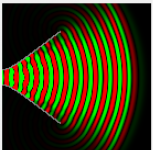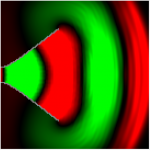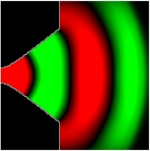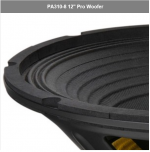I made that recommendation earlier. It should do fine and I like the more efficiency of this one vs the one you picked out. I personally lean to Eminence woofers but for a student on a budget it should do great. You will not need to attenuate the horn as much.
More information. The horn used is not set in stone. Use a cheaper Dayton or something in Canada if you can to save money. I do like the Selenium driver for cost vs performance.
http://techtalk.parts-express.com/s...-Your-PCD-Mettle/page23&p=1657414#post1657414
I've been told anything less than a 12" woofer will have too wide a directivity to match the SEOS waveguide. But from what I can tell the 12" starts to beam from 1130hz up. Doesn't the baffle width determine how much lower it will beam? Does that mean a 12" and an 8" will beam the same amount in the same baffle? I figure this is wrong so could someone set me straight. Thanks
Below where the waveguide has control, the baffle may hold directivity to 180 degrees. It is typical to cross above this, hence finding a woofer that is beaming to the wanted angle at the wanted crossover frequency.
Horizontally this waveguide may hold its directivity to around 1k, but vertically it is only half that dimension. If for example you chose to cross at approximately 2k, you might choose an 8" driver for 45 degrees.
The vertical angle here appears to be less than 45 degrees so you might use a larger driver.
Is there enough information to work this out?
Horizontally this waveguide may hold its directivity to around 1k, but vertically it is only half that dimension. If for example you chose to cross at approximately 2k, you might choose an 8" driver for 45 degrees.
The vertical angle here appears to be less than 45 degrees so you might use a larger driver.
Is there enough information to work this out?
I'll take a stab at it and maybe confuse you some more. As Allen said the baffle will hold the directivity to 180deg determined by the baffle width, and above that point the piston diameter starts to take over the pattern. A very general rule of thumb is a cone driver will have a 90deg pattern when the cone diameter=1wl. A 12" woofer actually has a cone diameter that's more like 10". 13500(speed of sound in ft)/10"=1350hz.....so the 12" driver will have a 90deg pattern at around 1350hz and it will progressively narrow above there. That's about where you'd want to xo. Like I said this is a general guideline but it will get you in the ballpark.
The SEOS 12 should hold a horizontal pattern down to around 1125hz (13500/12=1125) but there's enough data out there on that to know for sure. However, the vertical dimension is only about 6", so it will hold it's pattern down to about 2250hz (13500/6=2250) and below that it will progressively get wider. The trade-off there is you can get the ctc closer together with the short wg.
The SEOS 12 should hold a horizontal pattern down to around 1125hz (13500/12=1125) but there's enough data out there on that to know for sure. However, the vertical dimension is only about 6", so it will hold it's pattern down to about 2250hz (13500/6=2250) and below that it will progressively get wider. The trade-off there is you can get the ctc closer together with the short wg.
Doesn't the baffle width determine how much lower it will beam?
This is more to the point of the question, thanks nate. Normally the baffle won't be doing significant baffling until below the crossover...the baffle will hold the directivity to 180deg determined by the baffle width, and above that point the piston diameter starts to take over the pattern.
Ok, this is starting to make more sense. The problem is likely that I don't have a good 'minds eye' visual concept of how waves behave in these circumstances. Most of what I know about sound waves is from reading text. If you guys know of or come across a sim or video or picture you can shoot it to me any time.
Broadly speaking, the highs will separate from the horn and travel as previously directed, whereas the the lows will spill onto the outer surface. This is dependent on the wavelength and horn size.
The interruption at the end of the horn (its shape) will cause a disturbance to the edges of the higher frequency wavefront, whereas the lower frequency reflection is more straight back through the horn axis although this may be difficult to see in these pictures.
The interruption at the end of the horn (its shape) will cause a disturbance to the edges of the higher frequency wavefront, whereas the lower frequency reflection is more straight back through the horn axis although this may be difficult to see in these pictures.
Attachments
I realize that most pro 12" drivers have a foam lip on the frame surround. On this Dayton driver it is particularly pronounced. What is the reason for this and is this a source of diffraction?
It is so the driver can be mounted on the inside of the enclosure and seal against the baffle board. This was common back in the days of Altec and JBL front loaded horns. It also aids in hiding the glue line of the surround so that the surround is a bit prettier. These days it's a bit of a holdover...but a useful one.
Yes it could possible have some diffraction, but the driver will likely be beaming at any frequency high enough to diffract off that lip, so in practice the impact is negligible.
Also I am going to place the new order probably today. So...
Dayton PA310-8
Dayton D250P
SEOS-12
My only concern right now is vertical polars. I'd like the speakers to have even directivity whether I am lounging on the couch or standing up in the kitchen behind the couch. Is this realistic or with this system am I aiming for one or the other?
Dayton PA310-8
Dayton D250P
SEOS-12
My only concern right now is vertical polars. I'd like the speakers to have even directivity whether I am lounging on the couch or standing up in the kitchen behind the couch. Is this realistic or with this system am I aiming for one or the other?
- Status
- This old topic is closed. If you want to reopen this topic, contact a moderator using the "Report Post" button.
- Home
- Loudspeakers
- Multi-Way
- SEOS / Dayton 2 way



